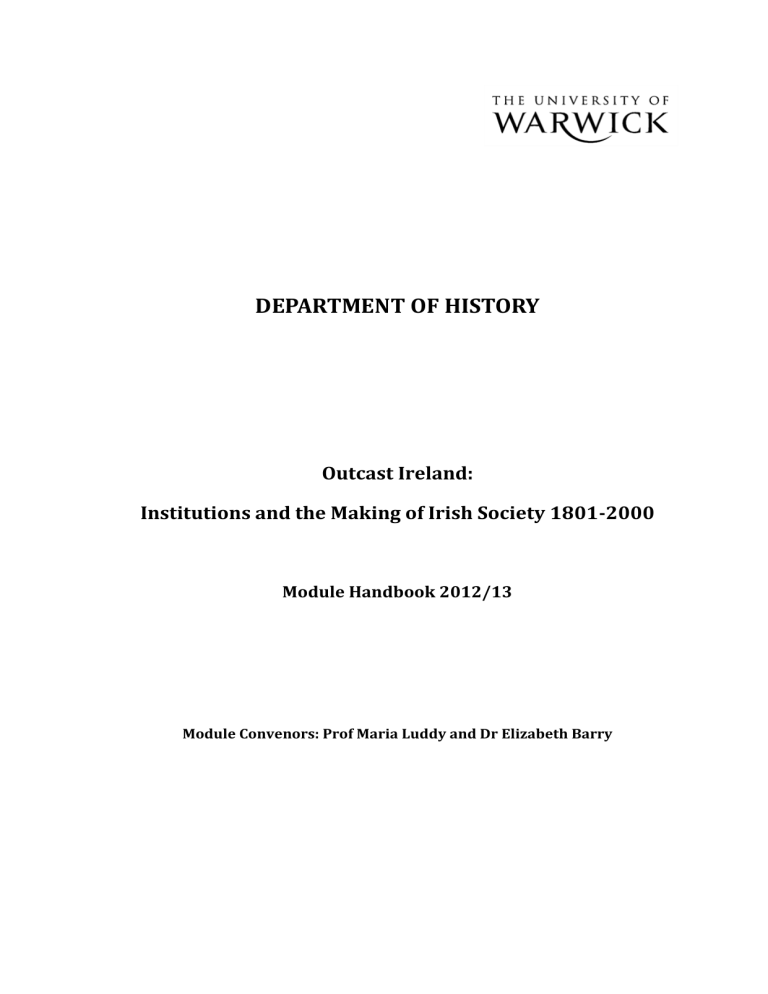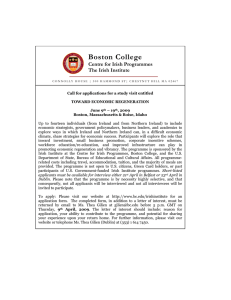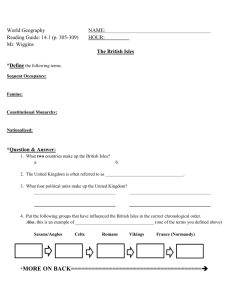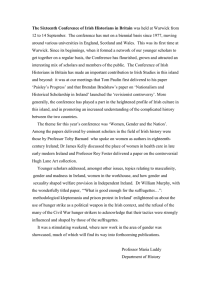DEPARTMENT OF HISTORY Outcast Ireland:

DEPARTMENT OF HISTORY
Outcast Ireland:
Institutions and the Making of Irish Society 1801-2000
Module Handbook 2012/13
Module Convenors: Prof Maria Luddy and Dr Elizabeth Barry
Introduction
The purpose of this course is to investigate, through a study of primary documents, literary responses, and secondary reading, a range of institutions that dealt with the ‘outcast’ (the poor, the diseased, the ill, prostitutes and unwanted children) in nineteenth and twentieth-century
Ireland. The institutions to be examined include workhouses, lunatic asylums, Magdalen asylums, and industrial and reformatory schools. Those participating in the course will discuss and analyse the history of these institutions, their function and development within a changing society, and their literary and cultural representations. The course will investigate how far the literature and non-fiction of the period offered ideological challenges, critiques and consolations for the troubled histories of these institutions. It will also consider the process of memorialisation at work in Irish culture: how the memory of these asylums and schools is constructed and perpetuated, and its effects on present-day Ireland.
Each session will begin with a short lecture on the theme noted in the course outline and we will then proceed to discuss the documents, literary works and the secondary reading.
Reading:
You are expected to read all of the items marked with an ** The secondary reading will give you the historical and literary background need to make sense of the primary texts.
General Texts:
To get as much as possible from this course it would be very useful for you to read the following general texts. Copies are available in the library.
Alvin Jackson, Ireland 1798-1998: War, Peace, and Beyond (Oxford, 2010, 2 nd
ed).
Caitriona Clear, Social Change and Everyday Life in Ireland, 1850-1922 (Manchester, 2007).
Diarmaid Ferriter, The Transformation of Ireland: 1900-2000 (London, 2004).
Diarmaid Ferriter, Occasions of Sin: Sex and Society in Modern Ireland (London, 2009).
All of the documents which have ‘In box’ after them are available from the History department’s post-graduate office. You may remove and read/copy these texts as required but you must return the original copies to the box so that all students can have access to the material. If copies go missing they will not be replaced.
1
Week 1: Issues in Irish History and Literature
Lecture Course and Planning
There is no separate reading list for this seminar.
In this first session we will talk generally about Irish history and literature in the 19th and 20th centuries, providing a general context for the module. We will then go through the syllabus, ensure that everyone has access to the reading materials and address any questions that arise at this stage.
2
Weeks 2 & 3: Workhouses and the Destitute
Historical Material
Documents:
Week 2:
Belfast Workhouse: Copies of Minutes of evidence taken at the recent inquiry held at the Belfast
Workhouse by Inspectors Bourke and Brodie, together with their report thereon, and final decision of the local government board; and, of any correspondence on this subject between the chief secretary for Ireland and the member for Clonmel (PP 1881 (123)). This document will be provided as a downloaded PDF document.
Week 3:
Suzanne Day, The Amazing Philanthropists (1916). A copy of this text will be made available to everyone.
The secondary reading is to enable you to get to grips with each topic and to explore how historians have written about these subjects. You will need background material, such as that by
Crossman, to be able to put the primary material in historical context.
The Belfast workhouse inquiry is a particularly interesting document that provides insights into how a workhouse actually functioned.
Keep the following queries in mind when reading this document:
What issues come to the attention of the authorities and how do they come to light?
Examine the relationships among the different functionaries of the workhouse.
What does this document tell you about the every day operation of a workhouse?
What does it tell you about the inmates of a workhouse?
How do issues of sexual immorality come to light and how are these issues dealt with?
What, from reading this document, do you think is the purpose of this inquiry?
For week 3, when reading Day’s The Amazing Philanthropists (a novel published in 1916) keep the following questions in mind and remember that Day herself was a poor law guardian.
Is fiction of any value to the historian?
Is Day’s book useful in any way in helping us understand the workings of the poor law system in early twentieth-century Ireland?
What do you think are the main concerns Day has with the poor law system?
Why is it written as a series of letters?
How are issues of class, gender and race dealt with in this novel?
What attitudes are expressed towards the poor?
Are there different kinds of poor people?
Secondary Reading
You don’t have to read every one of the following secondary sources but those marked with an
** will be very useful in helping you to gain an understanding of the subject.
Cousins, Mel, Poor Relief in Ireland, 1851-1914 (Bern, 2011), chapters 1-3 inclusive.
3
Crossman, V. and P. Gray (eds.), Poverty and Welfare in Ireland 1838-1948 (Dublin, 2011), chapters 1 -4 inclusive.
**Felix Driver, Power and Pauperism: The Workhouse System, 1834-1884 (Cambridge,
1993, reprinted 2004), chapter 6. In box
**Joseph Robins, The Lost Children: A Study of Charity Children in Ireland 1700-1900
(Dublin, 1980), chapter 12. In box
Lynn Hollen Lees, The Solidarities of Strangers: The English Poor Laws and the People,
1700-1948 (Cambridge, 1998), chapter 4. In box
**Helen Burke, The People and the Poor Law in 19 th
Century Ireland (Dublin, 1987), chapters 3 and 7. In box.
**Anna Clark, ‘Wild workhouse girls and the liberal imperial state in mid-nineteenth century Ireland’, Journal of Social History , 39, 2 (Winter 2005), 389-409. Available online.
Virginia Crossman, ‘The New Ross workhouse riot of 1887: nationalism, class and the Irish poor laws’, Past and Present (May 2003), 135-58. Available online.
**Virginia Crossman, The Poor Law in Ireland, 1838-1948 (Dundalk, 2006). This is the best introduction to the history of the poor law in Ireland and the library has a number of copies. It is a pamphlet and runs to about 70 pages, so do read this.
O’Brien, Gerard, 'The establishment of poor-law unions in Ireland,1838-43', Irish Historical
Studies , 23, 90 (November 1982), 97-120. IHS is available in the Library and through
JSTOR.
Literary Material
Primary texts
Week 2
Extracts from Nanno: Daughter of the State (1899)
Maura Laverty, Alone We Embark (1943; discussion will focus on pp. 78-100)
Nanno
What kind of community is “the House” (1-9) in Nanno ?
Think about the discourse that Mulholland employs. What kind of language does she use? How far is it coloured by moral considerations?
What kind of gap emerges between the “maxim” and the “practice” (10) of those who run the workhouse in Nanno ?
How far is the reader encouraged to sympathize with Nanno’s refusal to marry Sean, and Father
Tom’s endorsement of this decision?
Look again at the first chapter having read the whole story. Is Nanno’s fate determined by her birth and upbringing? How far is escape possible, in Mulholland’s representation?
Alone We Embark
4
Think about the role of the two men in authority, Mr Bergin, Mary’s employer, and Dr Mangan in the decision to put her mother in the workhouse (78-81)
What does Mary find off-putting about the workhouse? How far is class implicated in her aversion?
Alone We Embark was banned by the Irish Censorship Board for ten years. There is no documentation detailing why this was so: what aspects of the novel might have been deemed unacceptable?
Week 3
Suzanne Day, The Amazing Philanthropists (see above)
Augusta Gregory, ‘The Workhouse Ward’ (1908)
Sean O’Faolain, ‘The End of the Record’ (1942)
Think about the following as you read the Gregory and O’Faolain:
The Irish Literary Revival encompassed a new interest in Irish folklore and culture (songs and stories). How is this interest represented in these two treatments of the cultural anthropologist arriving at the workhouse?
How significant a setting is the workhouse? How benign or otherwise do the institution and its staff seem? How far has habituation to the institution affected the characters?
Is the Irish comic tradition, encompassing the satirical and the grotesque (see Roche , 173) exploited or critiqued in these works?
Think about the depictions of the following:
- poverty
- old age
- rural experience
How would you characterize their treatment (e.g. Sentimental? Satirical? Condescending?
Objective? Realistic?)?
Anthony Roche argues that the dramatic structure of a play such as The Workhouse Ward is
“based on repetition with variation, rather than any social or theatrical notions of development and climax”. Is the workhouse setting implicated in this ‘lack’ of development? Is this a strength or a weakness of Gregory’s work?
How far might O’Faolain’s story be in dialogue with Gregory’s play?
Secondary Reading
Heidi Hansson, ‘From Reformer to Sufferer: The Returning Exile in Rosa Mulholland ’s
Fiction’, in Michael Böss (ed.), Remapping Exile (Aarhus: Dolphin), 89-106 [scanned]
5
Caitriona Clear, ‘‘I Can Talk About It, Can’t I?’: The Ireland Maura Laverty Desired, 1942-
46’, Women’s Studies (2001)
Anthony Roche, ‘Reworking The Workhouse Ward : McDonagh, Beckett and Gregory’, Irish
University Review , 24 (2004), 171-184 [scanned]
6
Weeks 4 & 5: Industrial Reformatory Schools: Caring and
Corruption
In week 4 we will look at the history of industrial and reformatory schools in Ireland. Week five will explore the literary history of these institutions.
Historical Material
Week 4: Document:
Extract from the Ryan report. This will be made available to you.
In examining this document keep in mind the following questions:
What was the function and purpose of the Ryan commission of inquiry?
What was the context of the inquiry?
What issues arise around inquiries relating to child abuse within institutions?
What factors shape public inquiries?
Week 5: Literature
Kathleen O'Malley, Childhood Interrupted (Virago: London, 2005).
P. Touher, Fear of the Collar (O'Brien Press, Dublin, 2001)
Questions
1.
How do these texts provide 'an alternative narrative' of the past?
2.
What might be the motivations for such texts?
3.
How can we evaluate such texts?
4.
What are the common motifs of these texts?
5.
How do memoirs relate to the fictional representations of industrial and reformatory schools?
Secondary Reading
E. O’Sullivan and I. O’Donnell (eds.), Coercive Confinement in Ireland: Patients, Prisoners and Penitents (Manchester, 2012), part III.
Jane Barnes, Irish Industrial Schools, 1868-1908: Origins and Development (Dublin, 1989), chapters 4 and 7. In box.
Mary Rafferty and Eoin O'Sullivan, Suffer the Little Children: The Inside Story of Ireland's
Industrial Schools (New Island: Dublin, 1999). This is worth buying.
Barry Coldrey, '"A strange mixture of caring and corruption" : residential care in Christian
Brothers orphanages and industrial schools during their last phase, 1940s to 1960s'.
History of Education , 29:4 (2000), 343-56. In box.
Tony Flannery (ed.), Responding to the Ryan Repor t (Dublin, 2009).
Literary Material
Primary texts
Week 4
7
May Laffen Hartley, The Game Hen (1881)
Mannix Flynn, Nothing to Say (1983)
Game Hen
Think about the depiction of a) landscape, and b) rural life, and the unfortunate heroine’s relationship to it, in this story and Nanno .
What kind of relationship is invited with the morally ambiguous heroines?
Examine Petie’s committal to the industrial school. What form does it take? How benign is it? In what sense is he a “commodity”, as the cab driver alludes to him (Hartley, )?
How does Hartley’s story intervene in the debate over the merits of industrial schools?
Nothing to Say
What effect is created by the opening and closing ‘frame’ for the central story (11-12; 171-73)?
Think about the effect of other devices which problematize the documentary function of the narrative: the dream-like italicized passages, the fluidity with which the narrative switches between Dublin and Letterfrack life, the past and the present, etc.
Consider the depiction of the women involved in Gerard’s sentencing (his mother, the other mothers, the old woman with the prayer-book, the Probation Officer, the (female) Judge), the roles that they play, and their relationships with each other.
Think about the narrative voice and how far it is dispassionate about what is described.
“I never felt like a child in that cell” (Flynn, 39). How far does Gerard seem to be a child at this point in the narrative?
Compare the depiction of the industrial school, and the various ‘industries’ it contains, in The
Game Hen and Nothing to Say (ch. 4).
“This was the law of the inmates. The Brothers had their rules and the boys had theirs” (Flynn,
66). Consider the parallel codes of conduct and law that operate in the school.b
Secondary Reading
Michael Molino, ‘Surviving the ‘House of a Hundred Windows’: Industrial Schools in Irish
Writing’, New Hibernia Review 5.1 (2001) 33-52 [scanned]
Helena Kelleher Kahn, Nineteenth-century Ireland’s Political and Religious Controversies in the Fiction of May Laffan Hartley (Greensboro: ELT Press, 2005) [scanned]
Week 5
Kathleen O'Malley, Childhood Interrupted (Virago: London, 2005).
P. Touher, Fear of the Collar (O'Brien Press, Dublin, 2001) (See above.)
8
Patrick McCabe, The Butcher Boy (1994)
Patrick McCabe, The Butcher Boy (1994)
“I clammed up and gave her a sad, ashamed look instead” (74). Comment on this encounter between Francie (and the industrial school boys) and people on the ‘outside’.
“But he wasn’t that much of a cod” (81). How sympathetic is a) Francie, and b) the narrative to
Father Sullivan?
How significant (as Molino argues) is the moment when Francie tries to tell Joe about what
Father Sullivan did to him (97)?
Secondary Reading
Christopher FitzSimon, ‘St. Macartan, Minnie the Minx and Mondo Movies’, Irish University
Review, 28 (1998), 17?-185 [scanned]
James M. Smith, ‘Remembering Ireland’s architecture of containment: ‘telling’ stories in
The Butcher Boy and States of Fear ’, Eire-Ireland: A Journal of Irish Studies , 36 (2001)
[scanned]
Martin McLoone, ‘The abused child of history: Neil Jordan’s The Butcher Boy ’, Cineaste 23
(1998) [scanned]
Week 6:
History: Reading Week
English: Reading history and reading literature: presentations
9
Week 7: Asylums and the Construction of Madness
Historical Material
Documents:
3 committal warrants for lunatics 1904, 1911
Extract from First and Second Reports of the Committee Appointed by the Lord Lieutenant of
Ireland on Lunacy Administration (Ireland) (1891).
Questions
1.
Were the insane 'deserving' objects of relief?
2.
What kind of relationship existed amongst institutions such as lunatic asylums, prisons and workhouses?
3.
Is classification an important issue in lunatic asylums?
4.
What impact did one's gender have upon committal, treatment and release?
5.
How were lunatic asylums viewed by the general public?
Secondary Reading
E. O’Sullivan and I. O’Donnell (eds.), Coercive Confinement in Ireland: Patients, Prisoners and Penitents (Manchester, 2012), part I.
Mark Finnane, Insanity and the Insane in Post-Famine Ireland (Croom Helm: London,
1981), chapters 1, 4. (Available online as an e-book). In box.
‘Asylums, families and the state’, History Workshop Journal , xx (1985), pp 134-47.
Available online.
‘Law and the social uses of the asylum in nineteenth-century Ireland’, in D. Tomlinson and
J. Carrier (eds), Asylum in the Community (London, 1996), 91-110. In box.
Pauline Prior, Madness and Murder: Gender, Crime and Mental Disorder in Nineteenth-
Century Ireland (Dublin, 2008), chapter 2. In box.
Marcus Reuber, ‘Moral management and the unseen eye: public lunatic asylums in Ireland,
1800-1845’, in E. Malcom and G. Jones, (eds.), Medicine, Disease and the State in Ireland,
1650-1940 (Cork, 1999), pp. 208-33. In box.
David Wright, ‘Getting out of the asylum: understanding the confinement of the insane in the nineteenth century’, Social History of Medicine , x, (2001), 137-55. Available online.
Oonagh Walsh, ‘Lunatic and criminal alliances in nineteenth-century Ireland’, Peter
Bartlett and David Wright (eds), Outside the Walls of the Asylum: the History of Care in the
Community (London, 1999), 132-52. In box.
‘A lightness of mind: gender and insanity in nineteenth-century Ireland’, in Margaret
Kelleher and James H. Murphy (eds), Gender Perspectives in Nineteenth-Century Ireland
(Dublin, 1997), 159-67. In box.
Lindsay Prior, ‘The appeal to madness in Ireland’, in D. Tomlinson and J. Carrier (eds),
Asylum in the Community (London, 1996), 67-90. In box.
10
Literary Material
Primary texts
Week 7
Patrick McCabe, The Butcher Boy (1994)
Sebastian Barry, The Steward of Christendom (1995)
[Also worth reading, though not directly discussed in the seminar, is Sebastian Barry’s recent novel, The Secret Scripture (2008)]
The Butcher Boy
How far does McCabe draw parallels between the Industrial School and the psychiatric hospital
(the second “house with a hundred windows”)
Explore the relationship between madness and story-telling in McCabe’s novel. How much of what Francie tells the psychiatrists (146-47) is ‘genuine’ hallucination or delusion, and how much conscious fictionalization? “[H]e was mad to get information to write down”: is there any sense in which the institutional circumstances are ‘producing’ or have contributed to Francie’s insanity?
“You needn’t think you’re not seen” (McCabe, 148): be attentive to the trope of being seen, and being invisible in the works studied.
“…travel through the wastes of space and time” (148): is the experience of institutional time different from the experience of time on the ‘outside’?
The Steward of Christendom
“Smith: …If you weren’t an old madman, we’d flay you. / Mrs O’Dea: “That’s fine, Mr Smith, leave him be. Can’t you see you terrorise him? That’s him scrubbed” (Barry, 243).
Think about the institutional ‘care’ with which the play opens. What kind of relations are created between this and Thomas’s past life?
Think about the significance of clothing (and nakedness) in this institutional context (and others).
Explore the significance of the title of the play (cf. Barry, 250).
Think about the connotations of ‘asylum’ in Thomas’s case. In this, and in other representations of the psychiatric institution, how far is confinement embraced and how much resisted?
In what ways does this and other works give life to Stephen Dedalus’s comments in Ulysses about history as a “nightmare” from which he is trying to awake?
How is violence depicted?
11
Secondary Reading
Henry Sussman, ‘On the Butcher Block: A Panorama of Social Marking’, The New
Centennial Review 4 (2004): 143-68 [scanned; available online]
C. Wallace, ‘Running amuck: manic logic in Patrick McCabe's The Butcher Boy ’, Irish Studies
Review (1998) [scanned]
Maria Kurdi, ‘“Really all danger”: An Interview with Sebastian Barry’, New Hibernia Review,
Volume 8, Number 1, Spring 2004, 41-53 [scanned; available via Project Muse]
J. R. Meche, ‘Seeking "The Mercy of Fathers": Sebastian Barry's The Steward of
Christendom and the Tragedy of Irish Patriarchy’, Modern Drama , 2004, 47: 3, pages 464-
479
Elizabeth Butler Cullingford, ‘Colonial Policing: The Steward of Christendom and the
Whereabouts of Eneas McNulty’, Eire-Ireland , 39: 3+4 (Fall/Winter 2004), 11-37
[available via Project Muse: http://muse.jhu.edu/journals/eireireland/v039/39.3cullingford.pdf]
12
Weeks 8, 9 & 10: The Magdalen Asylums: Penitence and Social
Order
Week 8: We will watch a documentary on the Irish Magdalen Asylum.
Les Blanchisseuses de Magdalen (film), dir. Weber & Glimois
Questions
Les Blanchisseuses
Sister Lucy Bruton: “I don’t think we drove anyone to madness ...we institutionalized them”( Blanchisseuses ). Think about this in relation to this film, and previous discussions on this subject.
Week 9: We will explore the history of Magdalen Asylums through the primary and secondary literature.
Historical material
'Rules and regulations for the Sisters of Mercy' (1861)
‘The Magdalens of High Park’, The Irish Rosary , 1 (1897)
Extract from register of Sisters of Charity Magdalen Asylum, Dublin
Halliday Sutherland, Irish Journey (New York, 1958), ch. 7
Questions:
1.
What do the 'Rules and Regulations' tell us about how Magdalen Asylums were to be managed?
2.
How do perceptions of the Magdalen Asylum change over the period?
3.
What can we know about the inmates of these institutions?
4.
Why are there such differing interpretations of the history of Magdalen Asylums?
Secondary Reading
Frances Finnegan,
Do Penance or Perish: A Study of Magdalen Asylums in Ireland
(Oxford, 2004).
Maria Luddy,
Prostitution and Irish Society, 1800-1940
(Cambridge, 2007), chapter 3.
James Smith,
Ireland’s Magdalen Laundries and the Nation’s Architecture of
Containment (Manchester, 2008).
Week 10: We will explore the literary history of Magdalen Asylums.
Play
Patricia Burke Brogan, Eclipsed (1993)
13
Film
The Magdalene Sisters (film), dir. Peter Mullan. You will be expected to have viewed this film before class.
Questions
1.
James M. Smith argues that Ireland’s Magdalen institutions continue to exist in the public mind primarily at the level of story (cultural representation and survivor testimony) rather than history (archival history and documentation). If true, what implications might this have?
2.
Think about how the play, like other works on the course, illustrates the permeability of past and present.
3.
“Sister Virginia: …The women are drudges, are bond-women!” (46): think about the presentation of work in the play. What relationship do the women have to their work?
4.
“Brigit: …Why aren’t our lover-boys locked up too? One law for them and another for us!”
(60): this argument is echoed in recent historical readings of the legislation in force when the play is set. Explore this theme of gender inequality in your reading of the literary and historical works.
5.
Think about the convent-as-prison convention in the Gothic genre (see Cullingford, below)
– how is this invoked in Mullan’s film?
Secondary Reading
(Literature)
** Elizabeth Butler Cullingford, ‘Our Nuns are not a nation: politicizing the convent in Irish literature and film’, Éire-Ireland 41.1 (2006) 9-39 [available via Muse]
James M. Smith, ‘The Politics of Sexual Knowledge: The Origins of Ireland's Containment
Culture and the Carrigan Report (1931)’, Journal of the History of Sexuality , 13: 2, April 2004,
208-233 [available via JSTOR; linked from http://www2.bc.edu/~smithbt/publications.htm
]
14
Illustrative Bibliography
The following books provide good general histories of Ireland in the nineteenth and twentieth centuries. It is advisable that you read at least one of these texts.
Boyce, D.G., Nineteenth-century Ireland: The Search for Stability (Dublin, 1990). This is a good general text.
Foster, R.F., Modern Ireland 1600-1972 (London, 1988).
Hoppen, K.T., Ireland Since 1800: Conflict and Conformity (London, 1989).
Jackson, Alvin, Ireland, 1798-1998 (Oxford, 1999).
Keogh, D., Twentieth Century Ireland. Nation and State (Dublin, 1994).
Townshend, Charles, Ireland in the Twentieth Century, A Political History (London, 1998).
For works on the history of Irish literature you will find the following useful:
Foster, John Wilson (ed.), The Cambridge Companion to the Irish Novel (Cambridge, 2006).
Kelleher, Margaret and Philip O’Leary (eds), The Cambridge History of Irish Literature , 2 vols. (Cambridge ,2006).
You will also find The Field Day Anthology of Irish Writing vols. 1-3 (Derry/New York 1991) and the Field Day Anthology of Irish Writing: vols. 4-5, Irish Women’s Writings and Traditions (Cork/
New York, 2002), especially useful. Vols. 4 and 5 contain information on the place of women in
Irish history, society and culture from 600 to 2000.
For an introduction to Irish film see Martin McLoone, Irish Film: The Emergence of a
Contemporary Cinema (London, 2000).
You have access, through the Library, to an excellent bibliographic site (a database) that can be searched for books and articles published on British and Irish history. It is very straightforward to use and should be of great benefit to you when you need to find reading for an essay. The database you need is Bibliography of British and Irish History (BBIH).
The Library also holds a number of journals, either through JSTOR or on the shelves, which deal with Irish history, politics, literature and culture. These are:
1.
Irish Historical Studies
2.
Saothar: Journal of the Irish Labour History Society
3.
History Ireland
4.
Irish Review
5.
Irish Economic and Social History
6.
Irish Studies Review
7.
Eire/Ireland
8.
New Hibernia Review
The last three journals will contain many articles relevant to this course.
15
Assessment
Compulsory
1 assessed essay of 5,000 words.
Optional
You may, if you wish, complete an unassessed essay of 2,500 words which you submit to either
Maria Luddy or Elizabeth Barry in week 7.
16








